How and Why Companies Create Digital Replicas of Real-life Objects. Five Examples of Using Digital Twins in Different Industries
Sometimes, you have to deal with complex or unique entities that exist only in a single copy. Suppose you build an experimental wind turbine that has the potential to revolutionize green energy. The next step is to determine how well different parts interact with each other and find possible ways of improving their efficiency. Say you have some ideas on improving your invention, but building another model to validate your ideas is way too expensive. What could be the best way to solve this problem?
It is quite a significant issue for many industries that can't follow the trial-and-error method. For example, in architecture and construction, you can't rebuild cities multiple times before you find the optimal infrastructure model, and doctors don't have endless attempts to cure their patients. In these cases, digital twins may become pretty helpful. Today, we'll consider how this technology works and how it can benefit companies from various industries.
How Does the Digital Twin Technology Work?
A digital twin is a virtual representation of a real-life entity. It can be a physical object, such as a vehicle, airplane, or building, or, less often, a system or process, such as a supply chain, for example. In any scenario, these digital twins update from real-time data and rely on simulations, artificial intelligence, machine learning, data visualizations, and other technologies to enable data-based decision-making.
How to Build a Digital Twin?
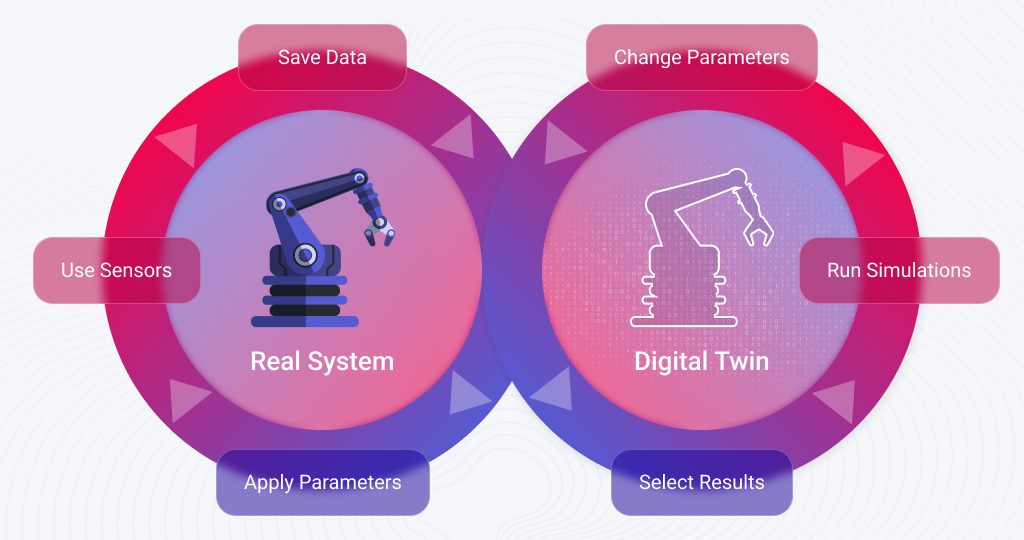
For instance, you can use multiple sensors in a physical object, such as a vehicle, to collect vital data that match your current needs. It could be its aerodynamic performance, fuel consumption, and other indicators. Data collected from these sensors can be transmitted to the system that creates and processes the digital copy of the physical object.
To create a digital twin of a supply chain, for example, to improve your services, you must first define all its integral parts and processes. It includes warehouses, transportation operations, production facilities, and relationships between them. Next, you collect specific data on these integral components, including warehouse locations, transportation routes, production rates, customer demand, etc. Using this data, you can create algorithms and simulations that replicate the supply chain behavior and work as its digital twin.
Read Also Freight Management System (FMS) vs. Transport Management System (TMS): Are They the Same Solution?
"How is this different from a digital simulation?" you may ask. First of all, simulations are usually built to study one specific process, whereas digital twins allow studying multiple processes and running as many simulations as the task requires. Unlike simulations, the digital twin is a technology that relies on two-way data flow. First, there's information coming from sensors, and second, insights generated by the system can influence objects the digital twin is based on. Also, digital twins rely on more accurate and up-to-date information combined with advanced ML algorithms, which allows for more significant potential in improving products, processes, and services.
Benefits of Using Digital Twins
If done right, digital twins can improve all aspects of a given product or service at every stage of its life cycle:
More efficient research and development. Digital twins is a technology that enables more efficient design of products and services. Tons of real-time data help generate valuable insights and refine the product before starting mass production;
Reduced time-to-market. Digital twins enable running virtual design-produce-test simulation loops at a much higher rate compared to building and testing physical prototypes;
Improved quality of products and services. With digital twins, companies can identify potential flaws earlier, decreasing the cost of their elimination and increasing the overall quality of the product or service;
Optimized production. Manufacturers can replicate their production systems to ensure they maintain optimal efficiency and find ways to achieve it if not;
Effective end-of-life management. Digital twins can help manufacturers predict products’ end-of-life and decide what materials can be recycled.
Are Digital Twins Suitable For Me?
With all these benefits, you may consider adopting the digital twin technology to improve your business's services. However, it doesn't suit every organization, product, or service. The reason is that not every object is extensive and complex enough to require a non-stop flow of real-time information, exact digital replicas, and multiple digital simulations. For example, the use of this technology is appropriate for:
Large objects, such as buildings, bridges, or offshore drilling platforms;
Mechanically complex objects, including vehicles, aircraft, or power-generation turbines;
Power equipment that generates power and relies on complex transmission grids;
Non-duplicate objects such as human organs or tissues requiring treatment;
Manufacturing projects and operations.
The digital twin technology applies to any industry with these or similar cases. Namely, you can create a digital twin for an object, process, or service in engineering, aircraft production, building, manufacturing, logistics, retail, and other fields. With all these benefits and a wide range of applications, it's unsurprising that this technology attracts much attention from businesses seeking better products and services. This rapidly expanding market is projected to hit around $269.1 billion by 2032:
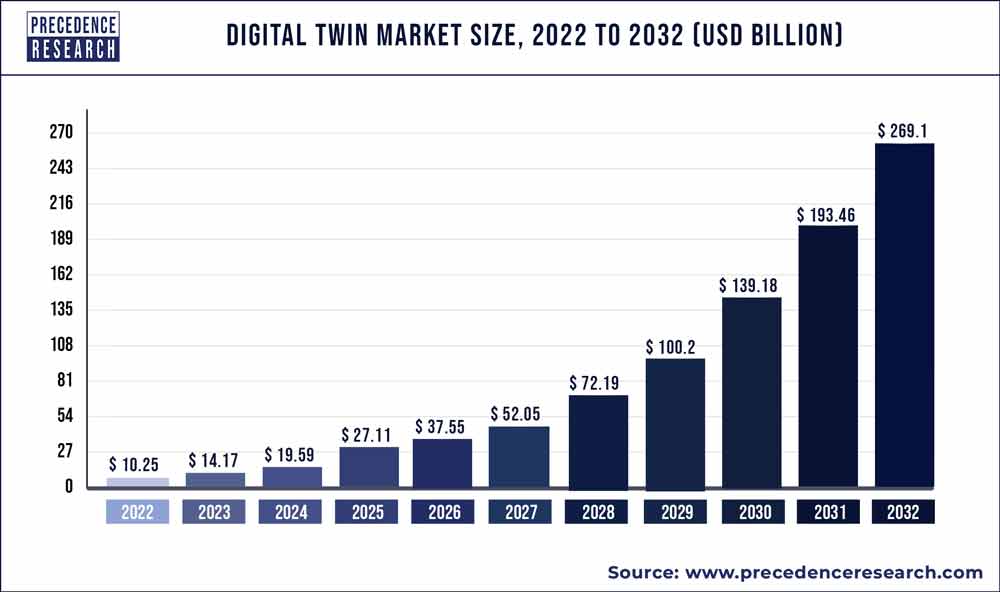
The best part about digital twins is that despite this technology looking futuristic, it has been around for decades. NASA pioneered its practical use during its space exploration missions in the 1960s. Therefore, it's not surprising that many companies today use this technology along with other, more familiar tools.
Five Examples of Using Digital Twins in Different Industries
1. Healthcare
In 2020, the digital twin concept of personalized medicine appeared. According to the idea, the digital twin technology could be used to create an unlimited number of virtual copies of a patient based on multiple models of disease-relevant variables. Then, each of these digital twins can be virtually treated with different drugs to find out which of them has the best effect for a given case:
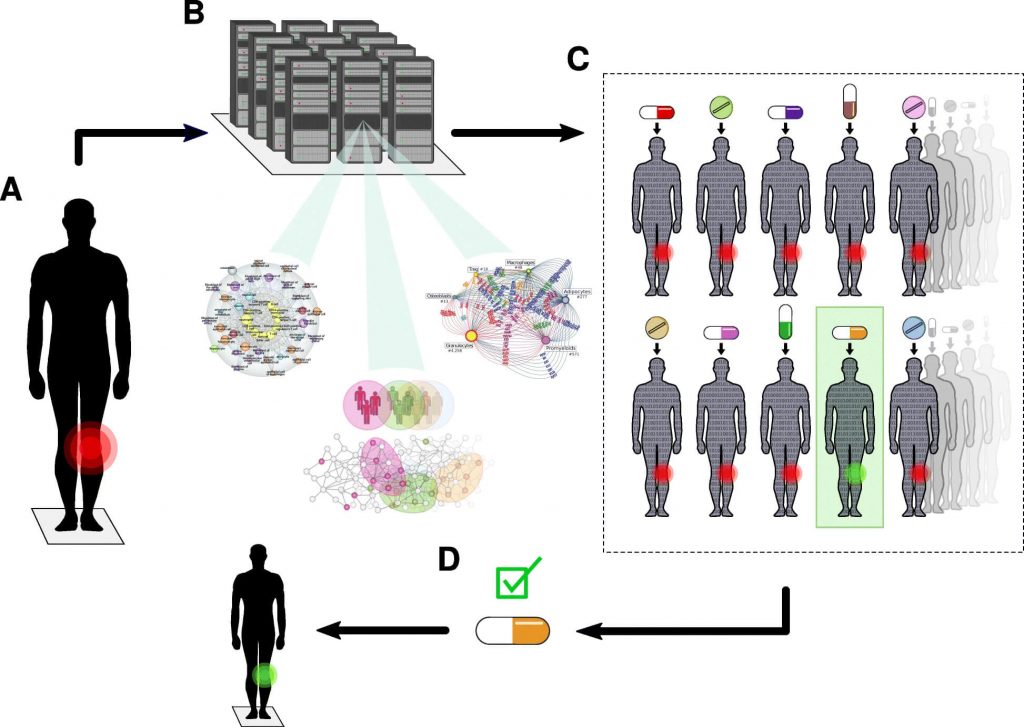
Today, this bold concept finds many practical embodiments in the healthcare industry. For example, the startup company ELEM BioTech enables the use of this technology in cardiology. They offer healthcare organizations a way to improve the quality of services provided by testing different drugs and treatment methods on virtual models of human hearts:
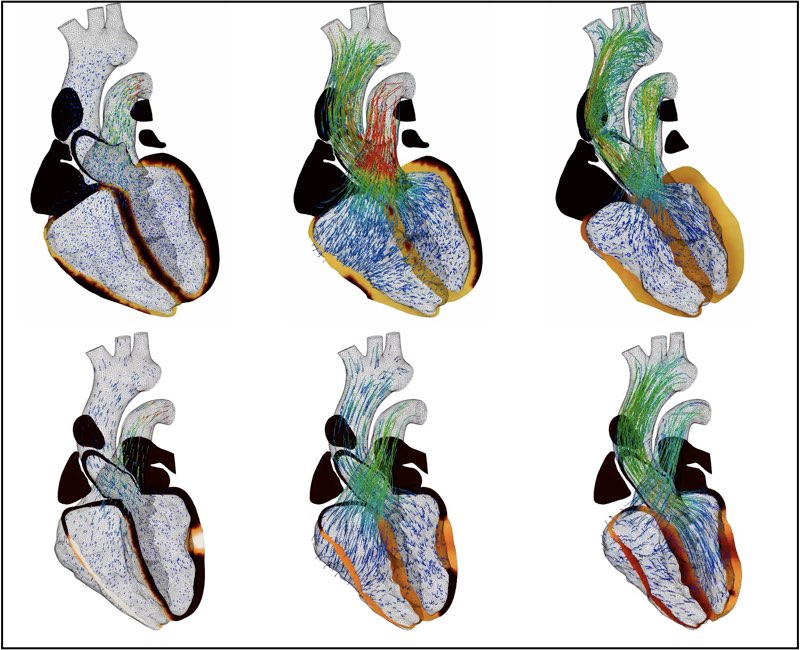
These models incorporate electrical activity, mechanical deformation, and fluid mechanics data. The system can run simulations to test how a heart works under different health, disease, and treatment conditions. The company also works on the technology of building a virtual respiratory system that enables the efficient analysis of drug-delivery efficiency of inhalers and nebulizers:
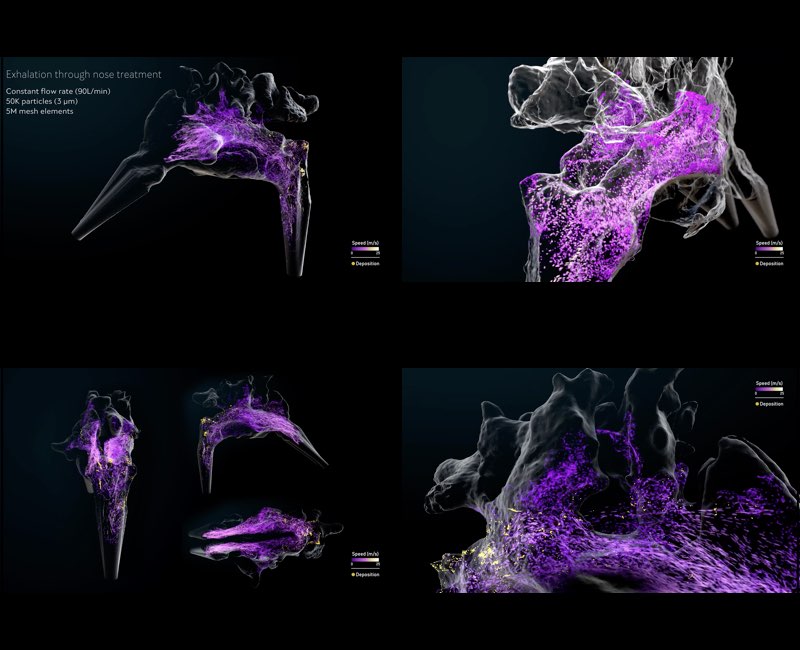
2. Manufacturing
In manufacturing, companies can create digital twins of real-life factories using many IoT sensors. These devices can help organize a data flow, including such indicators as temperature and motor speed, for further processing by machine learning algorithms. This approach helps identify the best operational conditions by running dozens of what-if scenarios.
That's what Unilever's digital journey plan looked like in a nutshell. The results exceeded all expectations. In 2023, the company's sites joined a network of the world's most digitally advanced factories. One of them, the largest laundry detergent powder factory in the world, is located in Brazil, and it has benefited dearly from adopting digital twin technology.
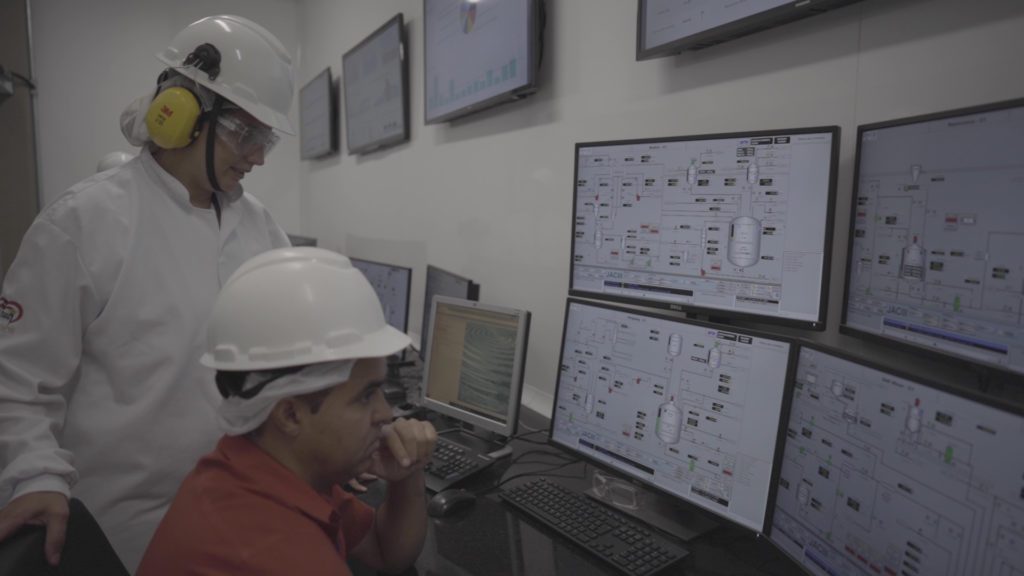
Source: Now it’s personal: Unilever’s digital journey leads to real results for consumers and employees
This factory's manufacturing processes are quite complex, making it hard to introduce changes and test how they impact the final product quality. Therefore, the company decided to build a digital twin and allowed AI software to find the optimal manufacturing parameters without the need for any physical intervention, which helped to speed up the development of a new product. Digital twin also helps predict the right time for equipment maintenance, which has allowed for a reduction of associated costs by almost half over five years.
3. Construction
Digital twins enable better resource management, improved communication between involved parties, efficient progress monitoring, and accurate predictions in the construction industry.
Pursuing these benefits, the Corgan company used the digital twin technology as a part of its workflow. This organization provides architecture and design services, and their challenge was to handle a $1.6 billion construction project at the Los Angeles International Airport. Among other devices, Corgan used the Matterport Pro2 camera in their work:
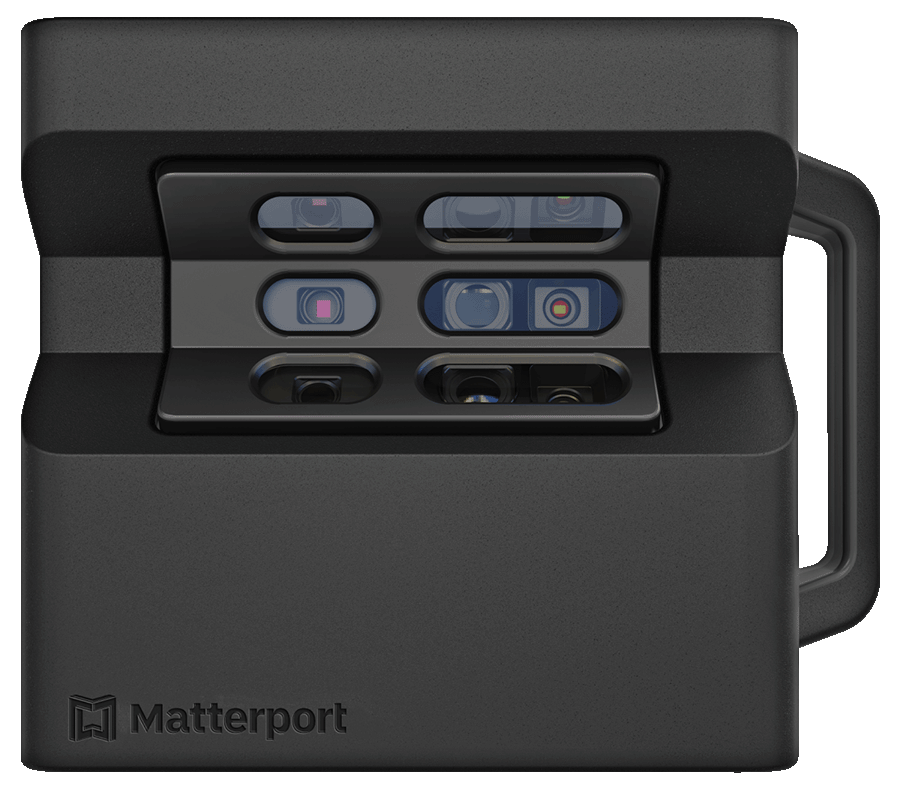
It allowed them to create 3D digital twins of buildings they worked on and share them with all the stakeholders. It, among other things, helped to improve the collaboration while working on this five-year project. Also, this technology helped to deal with another significant issue that every company providing construction services faces when working on large projects: accurately capturing the existing site conditions. For example, to create a digital replica of the utility tunnel with an area of more than 1500 square meters, the company only required 50 scans made in about an hour.
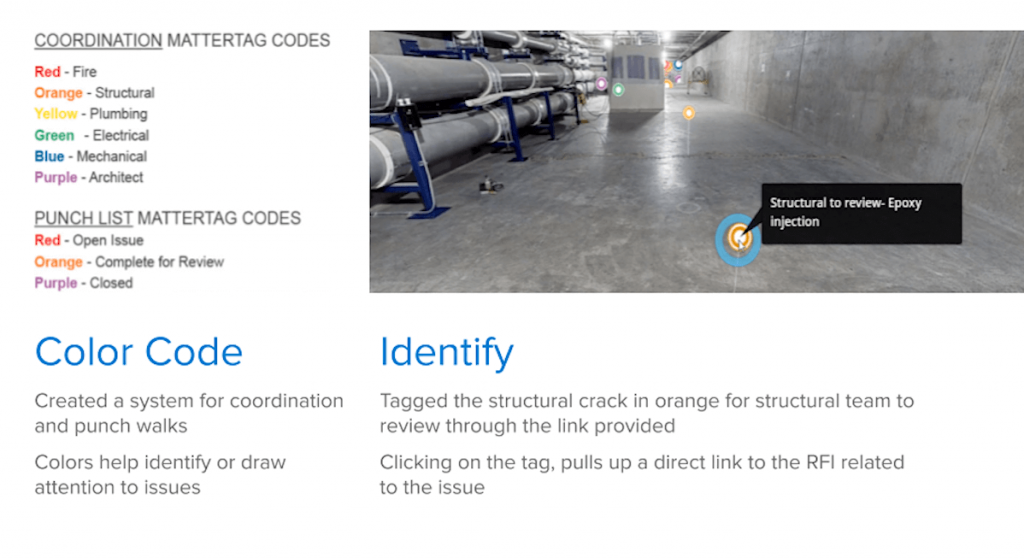
4. Automotive
It won't be a big surprise if we say that car manufacturers can also benefit from adopting the digital twin technology. Say the Renault company uses it to design its future vehicles. Comprehensive digital representations of the car include every facet, from bodywork and chassis to electronics and engine components. Company engineers can virtually seat drives inside the digital embryonic vehicle to test the ergonomics and human-machine interface (HMI).
Digital twins of designed cars go through multiple assessments, including crash tests, road scenarios, and wind tunnel testing, outpacing what physical tests could achieve:
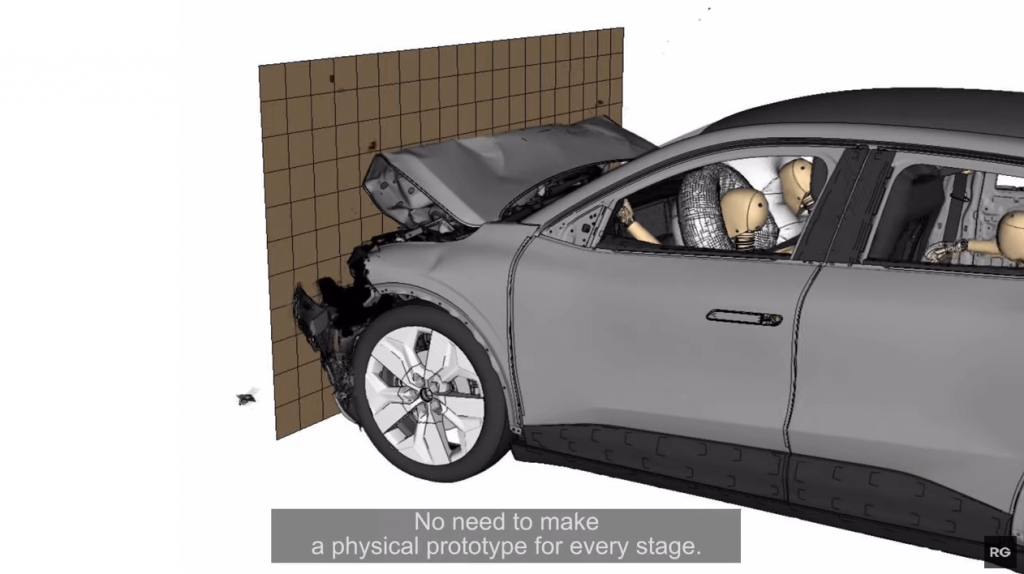
As successful technical features emerge from testing, they can be integrated into an optimal digital model. This mode can then become the blueprint for crafting the first physical mock-up.
5. Energy
There's a place for digital twins in energy and utilities as well. Say there's General Electric's Digital Wind Farm, where data is fed from sensors on each turbine to their digital replicas to facilitate more efficient designs and suggest optimizations for active turbines. It was designed and built to integrate hardware and software to monitor and optimize energy generation. This combination can boost energy production by up to 20%, translating to an additional $100 million in revenue over the turbine's lifespan and resulting in more efficient use of green energy.
Read also: Using the Power of the Earth’s Core. Geothermal Energy Advantages and Future Development
The process begins with a cloud-based digital twin model of the wind farm, allowing engineers to experiment with up to 20 turbine configurations, ensuring optimal design for the farm's real-life location. Once the physical turbine is in place, the digital twin model actively collects and analyzes data, providing continuous suggestions for enhanced efficiency.
Conclusions
Building accurate digital replicas of real-time objects is irreplaceable when you work with something so large, complex, or unique that you can't afford to follow the trial-and-error approach. There's plenty of suitable hardware that can get the job done. Sensors, IoT devices, and various cutting-edge cameras are always at your service. Integrate them with the right software, such as AI and ML algorithms and data visualization tools, and nothing will stop you from creating your own digital twin of almost anything you work with.
